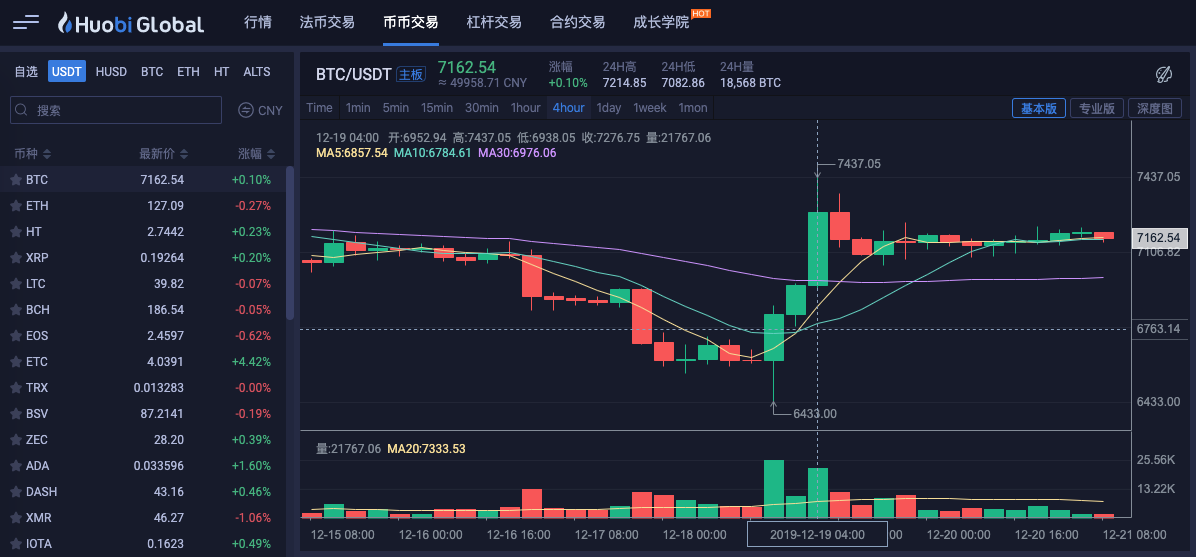手把手教你写一个Python版的K线合成函数
Author: 发明者量化-小小梦, Created: 2019-12-21 09:38:26, Updated: 2024-12-15 15:59:54
手把手教你写一个Python版的K线合成函数
在编写、使用策略时,经常会使用一些不常用的K线周期数据。然而交易所、数据源又没有提供这些周期的数据。只能通过使用已有周期的数据进行合成。合成算法已经有一个JavaScript版本了(链接),其实移植一段JavaScript代码为Python版本很简单。接下来我们一起写一个Python版本的K线合成算法。
JavaScript版本
function GetNewCycleRecords (sourceRecords, targetCycle) { // K线合成函数
var ret = []
// 首先获取源K线数据的周期
if (!sourceRecords || sourceRecords.length < 2) {
return null
}
var sourceLen = sourceRecords.length
var sourceCycle = sourceRecords[sourceLen - 1].Time - sourceRecords[sourceLen - 2].Time
if (targetCycle % sourceCycle != 0) {
Log("targetCycle:", targetCycle)
Log("sourceCycle:", sourceCycle)
throw "targetCycle is not an integral multiple of sourceCycle."
}
if ((1000 * 60 * 60) % targetCycle != 0 && (1000 * 60 * 60 * 24) % targetCycle != 0) {
Log("targetCycle:", targetCycle)
Log("sourceCycle:", sourceCycle)
Log((1000 * 60 * 60) % targetCycle, (1000 * 60 * 60 * 24) % targetCycle)
throw "targetCycle cannot complete the cycle."
}
var multiple = targetCycle / sourceCycle
var isBegin = false
var count = 0
var high = 0
var low = 0
var open = 0
var close = 0
var time = 0
var vol = 0
for (var i = 0 ; i < sourceLen ; i++) {
// 获取 时区偏移数值
var d = new Date()
var n = d.getTimezoneOffset()
if (((1000 * 60 * 60 * 24) - sourceRecords[i].Time % (1000 * 60 * 60 * 24) + (n * 1000 * 60)) % targetCycle == 0) {
isBegin = true
}
if (isBegin) {
if (count == 0) {
high = sourceRecords[i].High
low = sourceRecords[i].Low
open = sourceRecords[i].Open
close = sourceRecords[i].Close
time = sourceRecords[i].Time
vol = sourceRecords[i].Volume
count++
} else if (count < multiple) {
high = Math.max(high, sourceRecords[i].High)
low = Math.min(low, sourceRecords[i].Low)
close = sourceRecords[i].Close
vol += sourceRecords[i].Volume
count++
}
if (count == multiple || i == sourceLen - 1) {
ret.push({
High : high,
Low : low,
Open : open,
Close : close,
Time : time,
Volume : vol,
})
count = 0
}
}
}
return ret
}
有JavaScript算法,对于Python其实逐行翻译移植就可以了,遇到JavaScript的内置函数,或者固有方法,对应的去Python中查找对应的方法即可,所以移植还是比较容易的。
算法逻辑完全一模一样,只是JavaScript的函数调用var n = d.getTimezoneOffset(),移植到Python时,使用Python的time库中的n = time.altzone代替。其它差异仅仅是语言语法方面的了(例如for循环的使用,布尔值的差别,逻辑与、逻辑非、逻辑或的使用差别等..)。
移植后的Python代码:
import time
def GetNewCycleRecords(sourceRecords, targetCycle):
ret = []
# 首先获取源K线数据的周期
if not sourceRecords or len(sourceRecords) < 2 :
return None
sourceLen = len(sourceRecords)
sourceCycle = sourceRecords[-1]["Time"] - sourceRecords[-2]["Time"]
if targetCycle % sourceCycle != 0 :
Log("targetCycle:", targetCycle)
Log("sourceCycle:", sourceCycle)
raise "targetCycle is not an integral multiple of sourceCycle."
if (1000 * 60 * 60) % targetCycle != 0 and (1000 * 60 * 60 * 24) % targetCycle != 0 :
Log("targetCycle:", targetCycle)
Log("sourceCycle:", sourceCycle)
Log((1000 * 60 * 60) % targetCycle, (1000 * 60 * 60 * 24) % targetCycle)
raise "targetCycle cannot complete the cycle."
multiple = targetCycle / sourceCycle
isBegin = False
count = 0
barHigh = 0
barLow = 0
barOpen = 0
barClose = 0
barTime = 0
barVol = 0
for i in range(sourceLen) :
# 获取时区偏移数值
n = time.altzone
if ((1000 * 60 * 60 * 24) - (sourceRecords[i]["Time"] * 1000) % (1000 * 60 * 60 * 24) + (n * 1000)) % targetCycle == 0 :
isBegin = True
if isBegin :
if count == 0 :
barHigh = sourceRecords[i]["High"]
barLow = sourceRecords[i]["Low"]
barOpen = sourceRecords[i]["Open"]
barClose = sourceRecords[i]["Close"]
barTime = sourceRecords[i]["Time"]
barVol = sourceRecords[i]["Volume"]
count += 1
elif count < multiple :
barHigh = max(barHigh, sourceRecords[i]["High"])
barLow = min(barLow, sourceRecords[i]["Low"])
barClose = sourceRecords[i]["Close"]
barVol += sourceRecords[i]["Volume"]
count += 1
if count == multiple or i == sourceLen - 1 :
ret.append({
"High" : barHigh,
"Low" : barLow,
"Open" : barOpen,
"Close" : barClose,
"Time" : barTime,
"Volume" : barVol,
})
count = 0
return ret
# 测试
def main():
while True:
r = exchange.GetRecords()
r2 = GetNewCycleRecords(r, 1000 * 60 * 60 * 4)
ext.PlotRecords(r2, "r2")
Sleep(1000)
测试
火币行情图表

回测合成4小时图表

以上代码仅作为学习参考使用,如果用于具体策略中,请根据需求修改、测试。 如有BUG或者改进建议,欢迎留言,十分感谢 o^_^o
相关内容
- Quantitative Practice of DEX Exchanges (2) -- Hyperliquid User Guide
- DEX交易所量化实践(2)-- Hyperliquid 使用指南
- Quantitative Practice of DEX Exchanges (1) -- dYdX v4 User Guide
- Introduction to Lead-Lag Arbitrage in Cryptocurrency (3)
- DEX交易所量化实践(1)-- dYdX v4 使用指南
- 数字货币中的Lead-Lag套利介绍(3)
- Introduction to Lead-Lag Arbitrage in Cryptocurrency (2)
- 数字货币中的Lead-Lag套利介绍(2)
- Discussion on External Signal Reception of FMZ Platform: A Complete Solution for Receiving Signals with Built-in Http Service in Strategy
- FMZ平台外部信号接收的探讨:策略内置Http服务接收信号的完整方案
- Introduction to Lead-Lag Arbitrage in Cryptocurrency (1)
更多内容
- 定量分型速率交易策略
- Python版单平台均衡策略
- 老码农的踩坑之旅
- 一个95后炒币者的自述
- 手把手教你把Python单品种策略改造成多品种策略
- 我的自动化亏钱及FMZ上岸之旅
- FMZ心路历程--附送跃迁策略
- Python版追涨杀跌策略
- Python版简单网格策略
- 开箱即用的数字货币期权量化交易工具
- 手把手教你给策略增加多图表支持
- 基于数据回放功能开发的线性挂单流策略
- 手把手教你移植一个麦语言策略(进阶)
- 数字货币量化交易入门FAQ
- 发明者量化FMex挖矿策略使用指南
- 区块链资产量化交易中的跨币种对冲策略
- 改造Deribit期货API以适应期权量化交易
- 手把手教你写策略--移植一个my语言策略
- 使用研究环境分析三角对冲细节以及手续费对于可对冲差价的影响
- Introducing FMZ Quant data science research environment
homily /upload/asset/30da6ebb64b8003b1686.jpg 啊哈 ,梦梦老师技术比我高。截图给梦梦老师参考。
homily py 用resample函数 一行搞定了。
发明者量化-小小梦 赞,我Python 不行,只是初学。
发明者量化-小小梦 666 学习下。